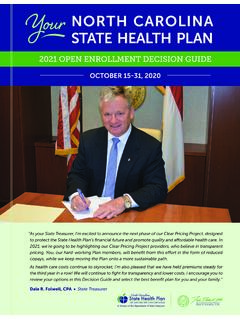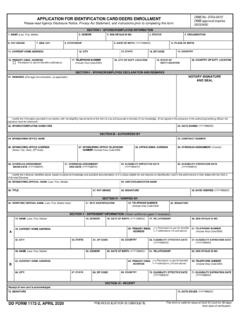Transcription of Agent and Broker Training and Testing Guidelines
1 Agent and Broker Training & Testing Guidelines 1 Agent and Broker Training & Testing Guidelines Introduction Each year, the Centers for Medicare & Medicaid Services (CMS) provides Medicare Advantage Organizations (MAOs)/Part D sponsors Training and Testing requirements for their agents and brokers. Plans/Part D sponsors should at a minimum use the criteria outlined below in developing their individual Training and Testing . The Agent and Broker Training Guidelines are based on CMS Medicare Managed Care Manual (MMCM), CMS Medicare Prescription Drug Benefit Manual (MPDBM), Medicare Communications and Marketing Guidelines (MCMG), and regulations at Title 42 of the Code of Federal Regulations, Parts 417, 422, and 423). Plans/Part D sponsors (including 3rd party vendors, if applicable) must ensure that all their agents and brokers (including employed, subcontracted, downstream, and/or delegated entities) that sell Medicare products are trained and tested annually on Medicare rules and regulations and on the specific plan types their agents and brokers sell.
2 Plans/Part D sponsors must ensure the integrity of their Training and Testing program to include that all agents and brokers are tested independently. Finally, Plans/Part D sponsors must maintain information on their Training and Testing programs and make this information available to CMS upon request. This includes tools, exams, policies and procedures, and evidence of completion. The suggested Training topics are outlined below. Plans/Part D Sponsors also should ensure that their agents/brokers can speak to these general topics and their relation to the types of plan products they sell ( , Part C, Part D, Cost Plans, etc.) 1. Medicare Basics a. Overview of Medicare i. Medicare Parts and covered services 1. Medicare Part A: Original Medicare - Hospital Insurance 2. Medicare Part B: Original Medicare - Medical Insurance 3. Medicare Part C: Medicare Advantage 4.
3 Medicare Part D: Prescription Drug Coverage Stand-alone PDP and MA-PD b. Eligibility requirements and premiums i. Original Medicare (Part A and Part B) ii. Part C iii. Part D 1. including applicable premiums, cost-sharing subsidies for low-income individuals iv. Section 1876 Cost Plans c. Overview of Medigap Agent and Broker Training & Testing Guidelines 2 d. Options for receiving Medicare i. Original Medicare only ii. Original Medicare with a stand-alone PDP iii. MA-PD iv. MA or Cost Plan without stand-alone PDP v. Cost Plan with a stand-alone PDP vi. Private Fee-for-Service e. A high level description for each of the Plan Types i. Original Medicare (Parts A and B) 1. Benefits and beneficiary protections (1-800-Medicare, FFS appeal rights, etc.) 2. Individual enrollment and entitlement for supplementary medical insurance (SMI) ii. Part C 1.
4 Description of coordinated care plans ( , HMO, PPO, RPPO, SNP, etc.) 2. Description of Private Fee-for-Service Plans 3. Benefits and beneficiary protections (grievance and appeal rights, prior authorization, step therapy, benefit limitations) 4. Out of Pocket costs ( , premiums, cost-sharing, copayments/coinsurance, MOOP limits) 5. Network requirements (in and out of network providers) 6. Disease Treatment plan 7. Description of how doctors are paid 8. Description of Medical Savings Accounts (MSA) iii. Part D 1. Description of plan types (MA-PD, Prescription Drug Plan) 2. Benefits and beneficiary protections (grievance and appeal rights) 3. Standard benefit a. TrOOP, coverage gap, catastrophic coverage b. Medicare Coverage Gap Discount Program 4. Pharmacy Networks a. In-network versus out-of-network coverage b. Preferred and standard cost-sharing for network pharmacies iv.
5 Other Plan Types 1. Employer Group Plans 2. Cost Plans 3. Optional: Programs of All-Inclusive Care for the Elderly (PACE) 2. enrollment and Disenrollment (Part C, Part D, and Section 1876 Cost Plans where applicable) a. enrollment Procedures i. Format of enrollment requests (use of approved enrollment mechanisms) ii. Appropriate use of short enrollment forms or model plan selection forms (Part C and D) or Simplified (Opt-In) enrollment Mechanism (Part C) Agent and Broker Training & Testing Guidelines 3 iii. Requirement that enrollment mechanism capture beneficiary s acknowledgement and consent to required key elements b. enrollment Processing i. enrollment effective dates ii. Notifications c. Non-discrimination requirements for enrollment d. Part C and D enrollment periods i. Description of the limited circumstances for making a mid-year change in enrollment ii.
6 Initial Coverage Election Period (ICEP) iii. Annual Election Period (AEP) iv. Initial enrollment Period for Part D (IEP for Part D) v. MA open enrollment Period (MA OEP) vi. open enrollment Period for institutionalized in individuals (OEPI) vii. Special enrollment Periods (SEP) 1. 5-Star Special enrollment Period 2. Provide other examples of SEPs ( , moving to a different service area, change in dual/LIS status, CMS/State Assignment, etc.) 3. Limitation on dual/LIS SEP for potential at-risk or at-risk individuals viii. Section 1876 Cost Plan open enrollment e. Disenrollment i. Voluntary disenrollment ii. Involuntary disenrollment ( , when a member must be disenrolled for moving out of service area, loss of dual eligible status, etc.) 3. Communication and Marketing Requirements and Other Regulations (Part C, Part D, and Section 1876 Cost Plans where applicable) a.
7 Agent and Broker Responsibilities i. HIPAA privacy ii. Other responsibilities required by plan b. Communication and Marketing Overview i. Overview of each term including the activities and materials that apply ii. Description of general rules and requirements for Communication and Marketing iii. Provision of Star Ratings information, including instructions on how to access and use the information iv. Information on how to access and use the Summary of Benefits, Provider/Pharmacy Directory, Evidence of Coverage, Annual Notice of Change, and formulary, as applicable c. Standards for Communication and Marketing - Inappropriate/Prohibited Communication and Marketing Activities i. Conducting health screenings Agent and Broker Training & Testing Guidelines 4 ii. Providing cash or monetary rebates iii. Making unsolicited contact d. Potential Consequences of Engaging in Inappropriate or Prohibited Communication and Marketing Activities (prohibited activities, include but not limited to: conducting health screenings, providing cash or monetary rebates and making unsolicited contact) i.
8 Report requirements ii. Disciplinary actions iii. Termination iv. Forfeiture of future compensation e. Marketing/Sales Events i. Definition of marketing/sales events ii. Appropriate promotion of sales events iii. Examples of dos and don ts, including but not limited to: 1. Provision of refreshments, snacks, and meals 2. Soliciting enrollment applications prior to the start of the AEP 3. Requiring information as a prerequisite for events ( , contact information) iv. Notification of events to the plan, as applicable f. Personal/Individual Marketing Appointments i. Scope of appointment ii. Examples of dos and don ts, including but not limited to: 1. Discussion/marketing of non-health care products 2. Discussing products not agreed upon by the beneficiary g. Educational Events i. Appropriate promotion of educational events ii. Sponsorship, promotion iii.
9 Example of dos and don ts, including but not limited to: 1. Topics (Medicare, plan-specific premiums and/or benefits, etc.) 2. Displaying and/or distribution of marketing materials 3. Marketing activities 4. Provision of refreshments, snacks, and meals h. Nominal Gifts i. Examples of dos and don ts, including but not limited to: 1. Eligibility ( , all potential enrollees, regardless of enrollment in specific plan(s)) 2. Value ( , $15 or less, no more than $75 per year) 3. Refreshments, snacks, and meals 4. Cash, charitable contributions, and gift certificates/cards that can be readily converted to cash i. Cross-selling definition i. Health care related products definition and dos and don ts ii. Non-health care related products definition and dos and don ts j. Unsolicited contact, outside of advertised sales or educational events or mailings Agent and Broker Training & Testing Guidelines 5 k.
10 Referrals solicitation of leads from members for new enrollees i. Any solicitation for leads all communication types (requirements and restrictions) ii. Gifts for referrals (requirements and restrictions) l. Marketing in Health Care Setting i. Examples of dos and don ts, including but not limited to: 1. Conducting sales activities in common areas 2. Conducting activities where patients get care ii. Conducting activities in long term care facilities m. Agent and Broker Compensation i. Compensation Eligibility 1. Independent Agent (eligible) 2. Employed Agent ( Agent / Broker who only sells for one Plan/Part D sponsor are exempt from compensation requirements) 3. Referral fee (applicable to anyone) ii. Definition of compensation iii. Compensation types and definitions 1. Initial Compensation 2. Renewal Compensation 3. Referral Fees iv. Definition of like plan type and unlike plan type changes v.















